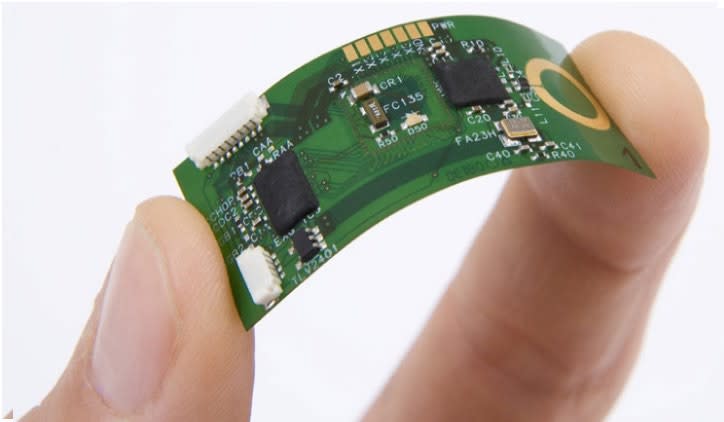
Introduction
The field of electronics has undergone a dramatic transformation in recent years, driven by the demand for smaller, lighter, and more portable devices. One technology that has played a pivotal role in this evolution is flexible circuits. Unlike traditional rigid circuit boards, flexible circuits offer enhanced flexibility and versatility, allowing for innovative designs and new applications. In this article, we will explore the impact of flexible circuits on the electronics industry, supported by existing technologies and real-world examples.
I. The Rise of Flexible Circuits
1.1 From Rigid to Flexible
Traditionally, electronics relied on rigid circuit boards, limiting the design possibilities and constraining the form factor of devices. However, advancements in materials science and manufacturing techniques have given rise to flexible circuits. These circuits utilize flexible substrates, such as polyimide or polyester, which allow for bending, twisting, and folding without compromising functionality.
1.2 Advantages of Flexible Circuits
Flexible circuits offer several advantages over their rigid counterparts. Firstly, their flexibility enables the creation of compact and lightweight electronic devices, making them ideal for wearable technology, portable gadgets, and even medical implants. Secondly, flexible circuits can be easily integrated into complex shapes, conforming to irregular surfaces and enabling seamless integration into various products. Finally, their robustness and resistance to vibration and shock make them suitable for applications where durability is crucial.
1.3 Real-World Applications
Flexible circuits have already made a significant impact in numerous industries. For example, companies like Fitbit and Apple have incorporated flexible circuits into their wearable devices, enabling comfortable and stylish designs. Additionally, the automotive industry utilizes flexible circuits for applications such as dashboard controls and lighting systems. These examples demonstrate how flexible circuits have reshaped the design and functionality of electronic devices across various sectors.
II. Technological Advances in Flexible Circuits
2.1 Printed Electronics and Roll-to-Roll Manufacturing
One of the key advancements in flexible circuits is the emergence of printed electronics and roll-to-roll manufacturing techniques. Printed electronics allow for the deposition of electronic components, such as conductive inks and semiconductors, onto flexible substrates using inkjet or screen printing methods. Roll-to-roll manufacturing, on the other hand, enables the continuous fabrication of flexible circuits, significantly reducing production costs and increasing scalability.
2.2 Stretchable Circuits and Elastic Materials
Another area of development in flexible circuits is the integration of stretchable circuits and elastic materials. These technologies enable the creation of circuits that can stretch and deform while maintaining electrical functionality. This opens up possibilities for applications in robotics, healthcare, and soft electronics. For instance, researchers have developed stretchable electronic skins that can be used for human-machine interfaces and healthcare monitoring.
2.3 Advances in Conductive Materials
The development of new conductive materials has also contributed to the advancement of flexible circuits. Graphene, for example, offers excellent electrical conductivity and mechanical flexibility, making it an attractive option for flexible electronics. Other materials, such as silver nanowires and conductive polymers, have also shown promise in enhancing the conductivity and stretchability of flexible circuits.
III. The Future of Flexible Circuits
3.1 Miniaturization and Wearable Electronics
The continued development of flexible circuits holds immense potential for miniaturization and wearable electronics. As components become smaller and more efficient, wearable devices can seamlessly integrate into clothing, accessories, and even the human body. The ability to monitor vital signs, track movement, and provide personalized feedback through flexible electronic systems will revolutionize healthcare, fitness, and communication.
3.2 Internet of Things (IoT) and Smart Devices
Flexible circuits will play a crucial role in the expansion of the Internet of Things (IoT) and the proliferation of smart devices. With their ability to conform to different form factors and integrate into various objects, flexible circuits will enable the seamless connectivity and intelligent functionality of everyday items. This will create a more interconnected world where devices communicate and collaborate to enhance efficiency and convenience.
3.3 Environmental Sustainability
The use of flexible circuits can also contribute to environmental sustainability. Their lightweight and energy-efficient nature can reduce the carbon footprint associated with electronic devices. Additionally, the adoption of flexible circuits in areas such as solar panels and energy harvesting devices can promote renewable energy solutions and reduce reliance on traditional power sources.
Conclusion
Flexible circuits have emerged as a transformative technology, reshaping the electronics industry and driving innovation in various sectors. With their enhanced flexibility, versatility, and integration capabilities, flexible circuits enable the development of compact and lightweight electronic devices, wearable technology, and smart devices. Advancements in printed electronics, stretchable circuits, and conductive materials continue to push the boundaries of what is possible with flexible circuits. As we look to the future, the potential applications of flexible circuits in miniaturization, IoT, and environmental sustainability are vast. It is clear that flexible circuits are set to redefine the way we interact with electronics, paving the way for a more connected, portable, and sustainable future.















